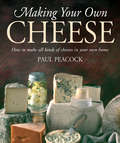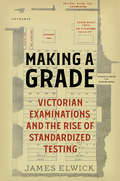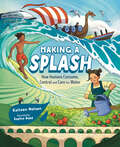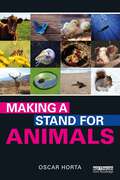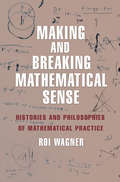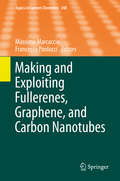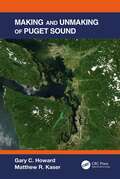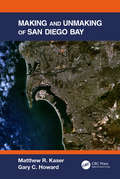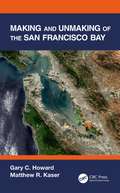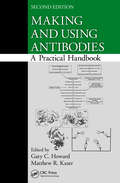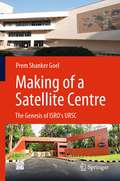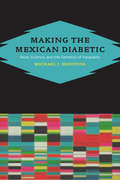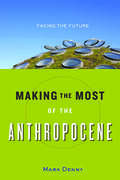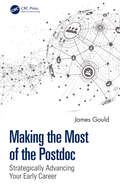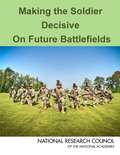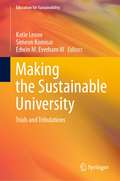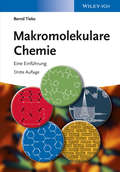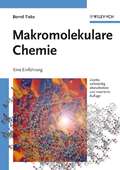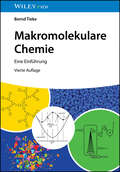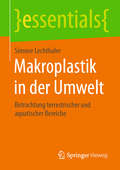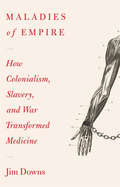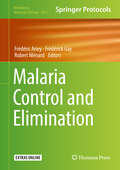- Table View
- List View
Making Your Own Cheese: How to Make All Kinds of Cheeses in Your Own Home
by Paul PeacockNot everyone can keep a cow, but everyone can make cheese. This book shows you the very basic equipment needed to make your own cheese: the ingredients, including different milks, herbs and flavours; how to make a simple cheese; and how to produce some of the worlds speciality cheeses such as Roquefort, Brie and Edam. You will find recipes for making many cheeses at home. Whether you are making a cheese cake, a ricotta-based pudding or a stonking salty blue, this book is a cheese lover s guide to making their own favourite food and there are some recipes for the biscuits to go with it, too.
Making a Grade: Victorian Examinations and the Rise of Standardized Testing
by James ElwickStarting in the 1850s achievement tests became standardized in the British Isles, and were administered on an industrial scale. By the end of the century more than two million people had written mass exams, particularly in science, technology, and mathematics. Some candidates responded to this standardization by cramming or cheating; others embraced the hope that such tests rewarded not only knowledge but also merit. Written with humour, Making a Grade looks at how standardized testing practices quietly appeared, and then spread worldwide. This book situates mass exams, marks, and credentials in an emerging paper-based meritocracy, arguing that such exams often first appeared as "cameras" to neutrally record achievement, and then became "engines" to change education as people tailored their behaviour to fit these tests. Taking the perspectives of both examiners and examinees, Making a Grade claims that our own culture’s desire for accountability through objective testing has a long history.
Making a Splash: How Humans Consume, Control and Care for Water (Orca Timeline)
by Colleen NelsonFrom where we live to what we eat, water plays a vital role in our survival. Since ancient times, water’s life-giving power has inspired people’s spiritual beliefs. It has influenced how humans migrated around the world. Recently, human ingenuity has taken water from a drinking source to an energy source, though not without consequences. As our population grows, cities expand and climate changes, what is the future of water? Innovations are making water equitable and accessible for all. Water warriors, determined to repair, protect and conserve water, are also shifting the mindset from humans needing water to water needing us. Making a Splash: How Humans Consume, Conserve and Care for Water looks at what has been done in the past and what can be done in the future to ensure the health and prosperity of our blue planet. The epub edition of this title is fully accessible.
Making a Stand for Animals
by Oscar HortaEngaging and thought-provoking, this book examines how humans see and treat other animals and argues that we should extend equal consideration and respect to all beings, human and nonhuman alike. Our world is plighted by ‘isms’ such as racism and sexism, but we may have overlooked a very important one: speciesism. Speciesism is a form of discrimination against those who don’t belong to a certain species. It drives us to see nonhuman animals as objects, rather than individuals with their own interests and with the ability to feel and suffer. This book questions all of the assumptions speciesism is based upon. It raises many challenging questions over humans' very complicated attitudes toward other animals. Thinking about how animals are used as well as the suffering of wild animals, and what the future may be for all beings, this book calls for society to seriously take into account the interests of all animals. For all who care about animals, or simply how to make the world a better place, this book is essential reading.
Making and Breaking Mathematical Sense: Histories and Philosophies of Mathematical Practice
by Roi WagnerIn line with the emerging field of philosophy of mathematical practice, this book pushes the philosophy of mathematics away from questions about the reality and truth of mathematical entities and statements and toward a focus on what mathematicians actually do—and how that evolves and changes over time. How do new mathematical entities come to be? What internal, natural, cognitive, and social constraints shape mathematical cultures? How do mathematical signs form and reform their meanings? How can we model the cognitive processes at play in mathematical evolution? And how does mathematics tie together ideas, reality, and applications?Roi Wagner uniquely combines philosophical, historical, and cognitive studies to paint a fully rounded image of mathematics not as an absolute ideal but as a human endeavor that takes shape in specific social and institutional contexts. The book builds on ancient, medieval, and modern case studies to confront philosophical reconstructions and cutting-edge cognitive theories. It focuses on the contingent semiotic and interpretive dimensions of mathematical practice, rather than on mathematics’ claim to universal or fundamental truths, in order to explore not only what mathematics is, but also what it could be. Along the way, Wagner challenges conventional views that mathematical signs represent fixed, ideal entities; that mathematical cognition is a rigid transfer of inferences between formal domains; and that mathematics’ exceptional consensus is due to the subject’s underlying reality.The result is a revisionist account of mathematical philosophy that will interest mathematicians, philosophers, and historians of science alike.
Making and Exploiting Fullerenes, Graphene, and Carbon Nanotubes
by Francesco Paolucci Massimo MarcaccioThe series Topics in Current Chemistry presents critical reviews of the present and future trends in modern chemical research. The scope of coverage is all areas of chemical science including the interfaces with related disciplines such as biology, medicine and materials science. The goal of each thematic volume is to give the non-specialist reader, whether in academia or industry, a comprehensive insight into an area where new research is emerging which is of interest to a larger scientific audience. Each review within the volume critically surveys one aspect of that topic and places it within the context of the volume as a whole. The most significant developments of the last 5 to 10 years are presented using selected examples to illustrate the principles discussed. The coverage is not intended to be an exhaustive summary of the field or include large quantities of data, but should rather be conceptual, concentrating on the methodological thinking that will allow the non-specialist reader to understand the information presented. Contributions also offer an outlook on potential future developments in the field. Review articles for the individual volumes are invited by the volume editors. Readership: research chemists at universities or in industry, graduate students.
Making and Unmaking of Puget Sound
by Gary C. Howard Matthew R. KaserThe Puget Sound is a complex fjord-estuary system in Washington State that is connected to the Pacific Ocean by the Juan de Fuca Strait and surrounded by several large population centers. The watershed is enormous, covering nearly 43,000 square kilometers with thousands of rivers and streams. Geological forces, volcanos, Ice Ages, and changes in sea levels make the Sound a biologically dynamic and fascinating environment, as well as a productive ecosystem. Human activity has also influenced the Sound. Humans built several major cities, such as Seattle and Tacoma, have dramatically affected the Puget Sound. This book describes the natural history and evolution of Puget Sound over the last 100 million years through the present and into the future. Key Features Summarizes a complex geological, geographical, and ecological history Reviews how the Puget Sound has changed and will likely change in the future Examines the different roles of various drivers of the Sound’s ecosystem function Includes the role of humans—both first people and modern populations. Explores Puget Sound as an example of general bay ecological and environmental issues
Making and Unmaking of San Diego Bay
by Gary C. Howard Matthew R. KaserSan Diego Bay is a shallow estuary surrounded by a large population center. Geological forces and changes in sea levels from the last Ice Age combine to make the Bay and the adjacent highlands and mesas. Human activity has also influenced the Bay. Humans built several major cities and filled significant parts of the Bay. This book describes the natural history and evolution of the San Diego Bay Area over the last 50 million years through the present and into the future. Key Features Summarizes a complex geological, geographical, and ecological history Reviews how the San Diego Bay has changed and will likely change in the future Examines the different roles of various drivers of Bay ecosystem function Includes the role of humans—both first people and modern populations—on the Bay Explores San Diego Bay as an example of general bay ecological and environmental issues Related Titles Howard GC and Kaser MR. Making and Unmaking of the San Francisco Bay (ISBN 9781138596726) Wang Y, ed. Remote Sensing of Coastal Environments (ISBN 978-1-1381-1638-2) Gonenc IE, Wolfin JB, eds. Coastal Lagoons: Ecosystem Processes and Modeling for Sustainable Use and Development (ISBN 978-0-3675-7814-5) Mossop E, ed. Sustainable Coastal Design and Planning (ISBN 978-0-3675-7075-0)
Making and Unmaking of the San Francisco Bay
by Gary C. Howard Matthew R. KaserSan Francisco Bay is a shallow estuary surrounded by a large population center. The forces that built it began with plate tectonics and involved the collision of the Pacific and North American plates and the subduction of the Juan de Fuka plate. Changes in the climate resulting from the last ice age yielded lower and then higher sea levels. Human activity influenced the Bay. Gold mining during the California gold rush sent masses of slit into the Bay. Humans have also built several major cities and filled significant parts of the Bay. This book describes the natural history and evolution of the SF Bay Area over the last 50 million years through the present and into the future. Key selling features: Summarizes a complex geological, geographical and ecological history Reviews how the San Francisco Bay has changed and will likely change in the future Examines the different roles and various drivers of Bay ecosystem function Includes the role of humans - both first peoples and modern populations - on the Bay Explores San Francisco Bay as an example of general bay ecolgical and environmental issues
Making and Using Antibodies: A Practical Handbook, Second Edition
by Gary C. Howard Matthew R. KaserAntibodies protect us from a wide range of infectious diseases and cancers and have become an indispensable tool in science-both for conventional immune response research as well as other areas related to protein identification analysis. This second edition of Making and Using Antibodies: A Practical Handbook provides clear guidance on all aspects
Making of a Satellite Centre: The Genesis of ISRO's URSC
by Prem Shanker GoelThis book tells the story of the evolution of the Satellite Center which started from a small Satellite Systems Division in 1967 with a handful of engineers to a vibrant R&D center which is playing the lead role in the Indian Satellite Program. India's space program is unique as it is driven by societal applications. The Indian Space Research Organisation (ISRO) has centers dedicated to various space applications. The ISRO Satellite Centre, now known as the UR Rao Satellite Centre (URSC), has evolved as lead center for Satellite Technology over five decades and has developed state-of-the-art satellites for applications such as remote sensing, satellite communication and space science. Through the story of URSC, the book describes the challenges of putting together new research and development centers and programs and conveys the importance of leadership and project management skills required to undertake such a task. This book is of interest to researchers, professionals, and administrators involved in the development of new R&D facilities and also to space scientists and space enthusiasts across the world.
Making the Connections: A How-To Guide for Organic Chemistry Lab Techniques
by Anne B. PadiasThe title of the book refers to the making of bonds to build the molecules that are an essential part of organic chemistry. The book is a user-friendly instructional tool designed to facilitate the learning process by including many every-day examples of the chemical principles used in the laboratory.
Making the Mexican Diabetic: Race, Science, and the Genetics of Inequality
by Michael MontoyaThis innovative ethnographic study animates the racial politics that underlie genomic research into type 2 diabetes, one of the most widespread chronic diseases and one that affects ethnic groups disproportionately. Michael J. Montoya follows blood donations from "Mexican-American" donors to laboratories that are searching out genetic contributions to diabetes. His analysis lays bare the politics and ethics of the research process, addressing the implicit contradiction of undertaking genetic research that reinscribes race's importance even as it is being demonstrated to have little scientific validity. In placing DNA sampling, processing, data set sharing, and carefully crafted science into a broader social context, Making the Mexican Diabetic underscores the implications of geneticizing disease while illuminating the significance of type 2 diabetes research in American life.
Making the Most of the Anthropocene: Facing the Future
by Mark DennyHumans have changed the Earth so profoundly that we’ve ushered in the first new geologic period since the ice ages. So, what are we going to do about it?Ever since Nobel Prize–winning atmospheric chemist Paul Crutzen coined the term "Anthropocene" to describe our current era—one in which human impact on the environment has pushed Earth into an entirely new geological epoch—arguments for and against the new designation have been raging. Finally, an official working group of scientists was created to determine once and for all whether we humans have tossed one too many plastic bottles out the car window and wrought a change so profound as to be on par with the end of the last ice age. In summer 2016, the answer came back: Yes. In Making the Most of the Anthropocene, scientist Mark Denny tackles this hard truth head-on and considers burning questions: How did we reach our present technological and ecological state? How are we going to cope with our uncertain future? Will we come out of this, or are we doomed as a species? Is there anything we can do about what happens next? This book• explains what the Anthropocene is and why it is important• offers suggestions for minimizing harm instead of fretting about an impending environmental apocalypse • combines easy-to-grasp scientific, technological, economic, and anthropological analyses In Making the Most of the Anthopocene, there are no equations, no graphs, and no impenetrable jargon. Instead, you'll find a fascinating cast of characters, including journalists from outer space, peppered moths, and unjustly maligned Polynesians. In his bright, lively voice, Denny envisions a future that balances reaction and reason, one in which humanity emerges bloody but unbowed—and in which those of us who are prepared can make the most of the Anthropocene.
Making the Most of the Postdoc: Strategically Advancing Your Early Career
by James GouldGraduate students and postdoctoral fellows spend upwards of 15 years honing their research skills. However, in all this training, compulsory career and professional development courses are far and few between. In the absence of a formal training curriculum, this co-curricular postdoc guidebook can be used as a manual for aspiring scientists to find career success. Postdocs face many hurdles in their pursuit of research excellence and independence. None more frustrating than making the most of this challenging yet rewarding opportunity. Ultimately, the point of postdoc training is not maintaining a lengthy postdoc tenure but landing a satisfying job. Regardless of what they do in their career, postdocs need to gain and master many skills both directly related to their scientific training and beyond. This book posits that if trainees are motivated and given some practical guidance, they can build a professional reputation while achieving a successful postdoc experience. Based on the personal experiences of the author, this book logically outlines the flow of the postdoc experience from beginning to end by providing actionable advice on how to get the most out of postdoctoral training while laying out strategies for choosing the right research environment to thrive along with planning, and executing, a successful postdoc tenure. Written for current and future postdocs, as well as their mentors, this book covers what they need know, and do, to strategically advance in their early research career. Key Features: Practical and actionable advice from an author that has experienced PhD and postdoc training, and is now directing a postdoc office at a world-renowned research institution Methodical approach most readers can readily adapt for their own purposes Specifically written for current and future STEM postdocs while being agnostic of the research field Dr. James Gould, PhD is Director of the HMS/HSDM Office for Postdoctoral Fellows at Harvard Medical School (HMS) where he has implemented research, career, and professional development programs and policies forHMS-affiliated trainees since 2011. Prior to HMS, Dr. Gould completed two postdoc fellowships at the National Cancer Institute of the NIH where he became involved in training affairs and studied cancer metabolism. Dr.Gould received his BS in Biotechnology/Molecular Biology from Clarion University of Pennsylvania and his PhD in Biochemistry and MolecularBiology from the University of Louisville.
Making the Rural Urban: Inter-Class Dynamics to Protect the Environment in a Gentrifying Rural Town in Colombia (Latin American Societies)
by Sebastián Felipe Villamizar-SantamaríaThis book takes the small rural town of La Calera, in the outskirts of the Colombian capital of Bogotá, as a case study to analyze how residents from different social classes – wealthier ex-urban newcomers arriving to traditionally peasant and rural areas – interact to decide how nature will be used in the face of further urban expansion. Contrary to the conflicts in other gentrification cases, including those of “green” gentrification, this book shows how newcomers and longtimers in La Calera use environmental concerns to bridge social class rifts and push the state to provide water, public space, and decision-making power. Residents see abundant ecological resources like water and land around them, but they do not have access to aqueducts, green public space or power over planning decisions affecting the distribution of these resources. As a response, and to challenge the state more effectively, newcomers and longtimers create inter-class alliances through what the author calls third nature: the way residents try to both protect and keep using existing ecological goods. To do so, despite high levels of class inequality, residents had a similar goal of protecting ecological resources around them by intervening in the physical and political landscapes against a state that induces scarcity, selectively enforcing environmental policies to the detriment of Calerunos. As cities all around the Global South continue to grow, urban expansion posits a threat to the environment by transforming agricultural and protected areas into denser residential or touristic spaces. Moreover, as natural resources become scarcer in the face of climate change, inequality might further existing environmental privileges and vulnerabilities. By examining closely how Calerunos bridge class inequalities for environmental reasons, this case highlights processes that inform other gentrifying rural spaces around the world.
Making the Soldier Decisive on Future Battlefields
by Division On Engineering Physical SciencesThe U. S. military does not believe its soldiers, sailors, airmen, and marines should be engaged in combat with adversaries on a "level playing field. " Our combat individuals enter engagements to win. To that end, the United States has used its technical prowess and industrial capability to develop decisive weapons that overmatch those of potential enemies. In its current engagement--what has been identified as an "era of persistent conflict"-- the nation's most important weapon is the dismounted soldier operating in small units. Today's soldier must be prepared to contend with both regular and irregular adversaries. Results in Iraq and Afghanistan show that, while the U. S. soldier is a formidable fighter, the contemporary suite of equipment and support does not afford the same high degree of overmatch capability exhibited by large weapons platforms--yet it is the soldier who ultimately will play the decisive role in restoring stability. Making the Soldier Decisive on Future Battlefields establishes the technical requirements for overmatch capability for dismounted soldiers operating individually or in small units. It prescribes technological and organizational capabilities needed to make the dismounted soldier a decisive weapon in a changing, uncertain, and complex future environment and provides the Army with 15 recommendations on how to focus its efforts to enable the soldier and tactical small unit (TSU) to achieve overmatch.
Making the Sustainable University: Trials and Tribulations (Education for Sustainability)
by Katie Leone Simeon Komisar Edwin M. Everham IIIThis book documents strategies for universities engaging sustainability challenges through the education of global citizens on topics such as climate change, habitat alteration, species loss, resource depletion and contamination, food access and sovereignty, economic equity, and energy use. Different disciplines and operational units often have disparate ideas in mind when they work toward advancing sustainability. For example, some disciplines focus on environmental challenges (identifying impacts to ecosystems, mitigation and remediation strategies), some on greening of industrial and commercial practices while others address social equity—often there is little effort to connect these pieces especially while considering economic impacts. This book examines how Florida Gulf Coast University has attempted to infuse sustainability across curricula and operations as an integrated concept and our successes and shortcomings are instructional for sustainability practitioners on college campuses and other industries in a wide audience.
Makromolekulare Chemie
by Bernd TiekeFür Chemiker, Polymerchemiker und besonders für Chemiestudenten ist die zweite Auflage des Tiekes wieder ein gelungenes und ausgewogenes Lehrbuch über das Basiswissen in der Makromolekularen Chemie. Mit der bereits bewährten Didaktik wird der Stoff der Makromolekularen Chemie in verständlicher Form und klar gegliedert dargestellt. Der Inhalt wurde verbessert, erweitert und aktualisiert. Neu behandelte Themen sind hierbei: lebende kationische und lebende radikalische Polymere, flüssigkristalline Polymere, elektrisch leitende Polymere, Polyelektrolyte, bioabbaubare Polymere und Verarbeitung und Recycling von Polymeren.
Makromolekulare Chemie: Eine Einführung
by Bernd TiekeFür Chemiker, Polymerchemiker und besonders für Chemiestudenten ist die zweite Auflage des Tiekes wieder ein gelungenes und ausgewogenes Lehrbuch über das Basiswissen in der Makromolekularen Chemie. Mit der bereits bewährten Didaktik wird der Stoff der Makromolekularen Chemie in verständlicher Form und klar gegliedert dargestellt. Der Inhalt wurde verbessert, erweitert und aktualisiert. Neu behandelte Themen sind hierbei: lebende kationische und lebende radikalische Polymere, flüssigkristalline Polymere, elektrisch leitende Polymere, Polyelektrolyte, bioabbaubare Polymere und Verarbeitung und Recycling von Polymeren.
Makromolekulare Chemie: Eine Einführung
by Bernd TiekeSeit mehr als 25 Jahren ist dieses Lehrbuch das Standardwerk zum Einstieg in die Makromolekulare Chemie. Kompakt, übersichtlich und verständlich werden die Synthese, Charakterisierung, Eigenschaften und Reaktionen sowie Anwendungen von Polymeren beschrieben. Für die vierte Auflage wurde das Buch komplett überarbeitet, aktualisiert und um wichtige Kapitel erweitert, wie z.B. natürliche Polymere und Biomakromoleküle, Dendrimere, hyperverzweigte Polymere und Sternpolymere, Synthesemöglichkeiten mittels Click-Chemie, Additive für Polymere, selbstheilende Polymere, Elektrospinnen, 3D-Druck von Polymeren und Mikroplastik. Durch die Änderungen sind der Materialaspekt und die technische Seite der Makromolekularen Chemie stärker betont worden. Neben einer Zusammenfassung der wichtigsten Inhalte am Ende jedes Kapitels sind erstmals auch Fragen und Antworten enthalten, die es ermöglichen, das erworbene Wissen selbstständig zu überprüfen und sich erfolgreich auf Prüfungen vorzubereiten. Mit seinem bewährten Konzept ist das Buch der ideale Begleiter für alle Studierenden der Chemie im Haupt- und Nebenfach sowie der Materialwissenschaften. Für Chemiker und Ingenieure, die sich in das Thema schnell einlesen wollen, sei dieses Buch ebenfalls wärmstens empfohlen!
Makromoleküle I: Von einfachen Chemierohstoffen zu Hochleistungspolymeren
by Helmut RitterEin praxisorientiertes Lehrbuch zum nachhaltigen Verständnis über Herstellung und Eigenschaften von Kunststoffen. Auch ökonomische und Umwelt-Aspekte werden umrissen. Das Buch richtet sich an Studierende der Chemie sowie an Forscher in Industrie und Instituten.
Makroplastik in der Umwelt: Betrachtung terrestrischer und aquatischer Bereiche (essentials)
by Simone LechthalerSimone Lechthaler zeigt, dass der Eintrag von Makroplastik in die Umwelt, der bereits in zahlreichen aquatischen und terrestrischen Bereichen nachgewiesen wurde, vollständig durch anthropogenes Handeln bedingt ist und daher ganzheitlich vermieden werden kann. Durch die Persistenz des Werkstoffes kommt es zu einer kontinuierlichen Akkumulation von Makroplastik in der Umwelt. Präventive Maßnahmen müssen daher weitreichend und intensiver thematisiert werden und auch Einfluss auf die (Umwelt-)Bildung nehmen, um den weiteren Eintrag einzugrenzen und möglichst zu verhindern. Die Autorin erläutert, dass die Interaktionen zwischen Makroplastik und der Umwelt noch nicht ausreichend untersucht und gesundheitliche Folgen für den Menschen noch unklar sind, für Tiere jedoch bereits ein Gesundheitsrisiko besteht.
Maladies of Empire: How Colonialism, Slavery, and War Transformed Medicine
by Jim DownsA sweeping global history that looks beyond European urban centers to show how slavery, colonialism, and war propelled the development of modern medicine. Most stories of medical progress come with ready-made heroes. John Snow traced the origins of London’s 1854 cholera outbreak to a water pump, leading to the birth of epidemiology. Florence Nightingale’s contributions to the care of soldiers in the Crimean War revolutionized medical hygiene, transforming hospitals from crucibles of infection to sanctuaries of recuperation. Yet histories of individual innovators ignore many key sources of medical knowledge, especially when it comes to the science of infectious disease. Reexamining the foundations of modern medicine, Jim Downs shows that the study of infectious disease depended crucially on the unrecognized contributions of nonconsenting subjects—conscripted soldiers, enslaved people, and subjects of empire. Plantations, slave ships, and battlefields were the laboratories in which physicians came to understand the spread of disease. Military doctors learned about the importance of air quality by monitoring Africans confined to the bottom of slave ships. Statisticians charted cholera outbreaks by surveilling Muslims in British-dominated territories returning from their annual pilgrimage. The field hospitals of the Crimean War and the US Civil War were carefully observed experiments in disease transmission. The scientific knowledge derived from discarding and exploiting human life is now the basis of our ability to protect humanity from epidemics. Boldly argued and eye-opening, Maladies of Empire gives a full account of the true price of medical progress.
Malaria Control and Elimination (Methods in Molecular Biology #2013)
by Robert Ménard Frédéric Ariey Frédérick GayThis detailed book serves to provide a global overview of the goals, rationale, and scientific basis for malaria control and elimination, as well as tools, methods, and strategies to that end. Opening with a section on malaria epidemiology, the volume continues by covering tools that are critical to malaria management, anti-malarial drugs and resistance to these drugs, vaccination approaches against malaria, vector control, as well as some perspective on the future of the fight against this devastating disease. Written for the highly successful Method in Molecular Biology series, chapters in this collection feature the kind of practical, hands-on advice that leads to better results in the field. Authoritative and important, Malaria Control and Elimination is a valuable reference for all those involved in malaria control and elimination worldwide, from students to health practitioners and field researchers seeking to make eradication a reality wherever possible.
